Me? Where do I start?
I’m Damian, I was born in the 80’s and I’m from the North-East coast of England.
I am neurodiverse and have mental health struggles.
I’m married to Alison and we’ve been together since our late teens.
I’m an ambulatory wheelchair user meaning I use a wheelchair but I can stand up for short lengths of time and take a few steps with support.
I call myself a Northern Gobshite as I’m quite loud, say it like it is and I’m passionate about what I do.
I'm easy to spot - I'm usually wearing a band or gig t-shirt, I only ever wear pink footwear and my wheelchair is bright pink!
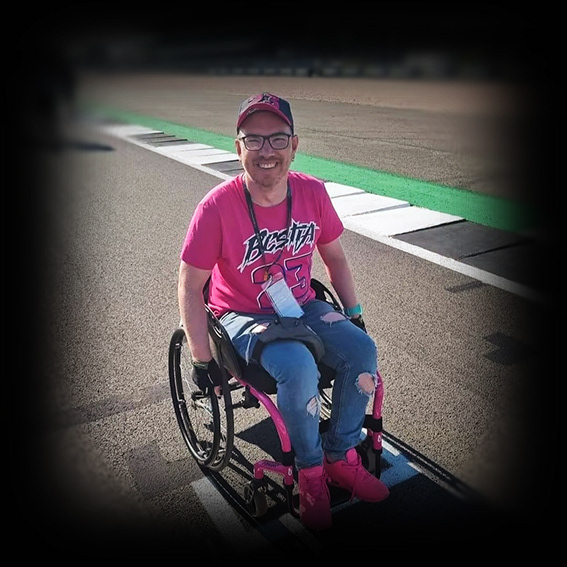
Damian, a white male wearing black framed glasses with a navy blue and pink baseball cap in a pink framed wheelchair. He is wearing a pink t-shirt with a logo reading Bestia 23, ripped blue, jeans, black fingerless gloves and pink shoes. He has a black lanyard around his neck with a white pass attached. The wheelchair is positioned in the number 1 grid spot on the Silverstone circuit and he is smiling to the camera
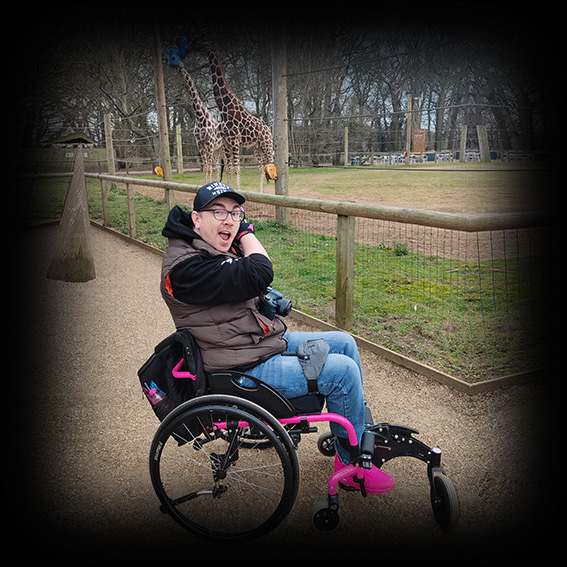
Damian, a white male wearing black framed glasses with a black baseball cap in a pink framed wheelchair. He is wearing a khaki gilet with a black hoodie underneath, blue jeans and pink shoes. He is outside at a wildlife park. He is turned with his right hand side to the camera. He is looking at the camera with a face that says ‘look!’, with both of his arms swung around to his left hand side, pointing towards 2 giraffes.
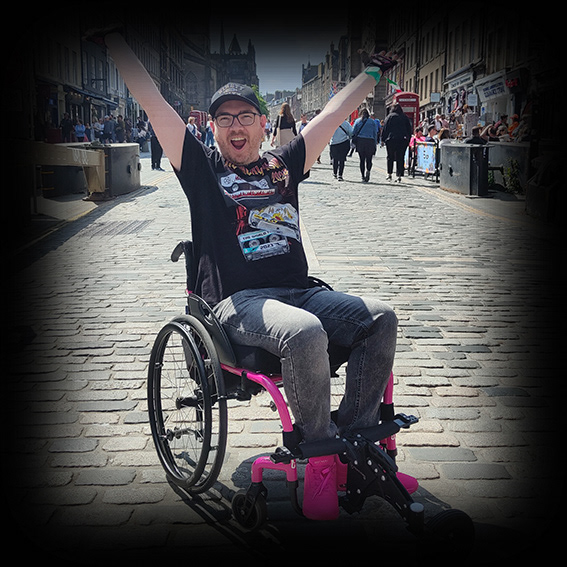
Damian, a white male wearing black framed glasses with a black baseball cap in a pink framed wheelchair. He is wearing a black tshirt, grey jeans and pink shoes. He is positioned on a cobbled street in Edinburgh in the sunshine. His chair is turned slightly to the left, his facial expression is happy and open-mouthed and he has both arms up in the air.
My passion is live music.
Feeling the beat pound in your chest.
That buzz of adrenaline hearing the band play that song that means so much to you.
Being in a room with other people with the same love as you.
When I was diagnosed with a genetic degenerative connective tissue disorder at the age of 14, I had no idea how my life would pan out. It was a lot to take in at the time with not a lot of information about the condition.
My education was affected from secondary school right through to university. I became aware that I couldn’t do things in the same way as everyone else. I would need to make sacrifices and accept additional help.
On a personal level, I tried to hide my mobility issues. I didn’t want to be seen as inferior to my peers. I wanted to be seen as normal, do normal things, and fit in.
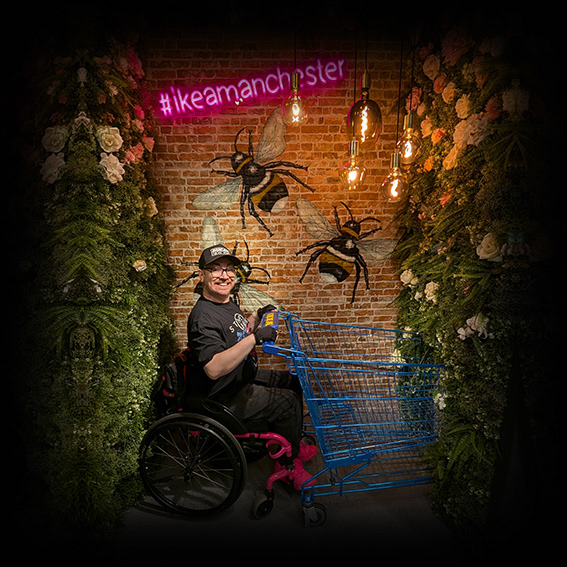
Damian, a white male wearing black framed glasses with a black baseball cap in a pink framed wheelchair wearing a black tshirt, jeans and pink shoes. He is positioned with his right hand side towards the camera. He is in a large photo booth with a brick wall at the back and flower and foliage walls on either side. There are gold light fittings hanging above. There are 2 large bees painted on the brick wall and a pink neon light reading #IkeaManchester. He is posing to the camera, pretending to push large blue supermarket trolley whilst cheesily grinning to the camera,

Damian, a white male wearing black framed glasses with short, mousy hair and is only shown from the chest upwards. He is pictured in his office, wearing a black t-shirt reading ‘The World Tour’ with framed music memorabilia. He is leaning forward slightly and smiling to the camera
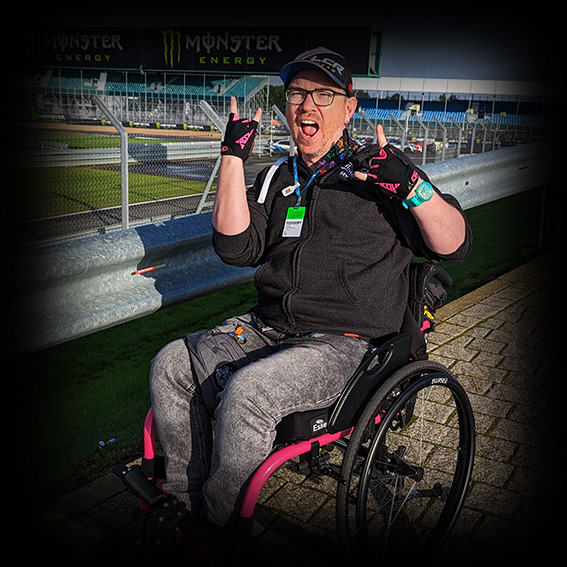
Damian, a white male wearing black framed glasses with a black LCR Honda baseball cap in a pink framed wheelchair. He is wearing a dark grey hooded top, grey jeans, black and pink fingerless gloves and pink shoes. His chair is turned slightly to the right and positioned in front of a metal crash barrier at the side of Silverstone racing circuit. His facial expression is happy and open-mouthed and both hands are making a rock devil horns hand gesture.
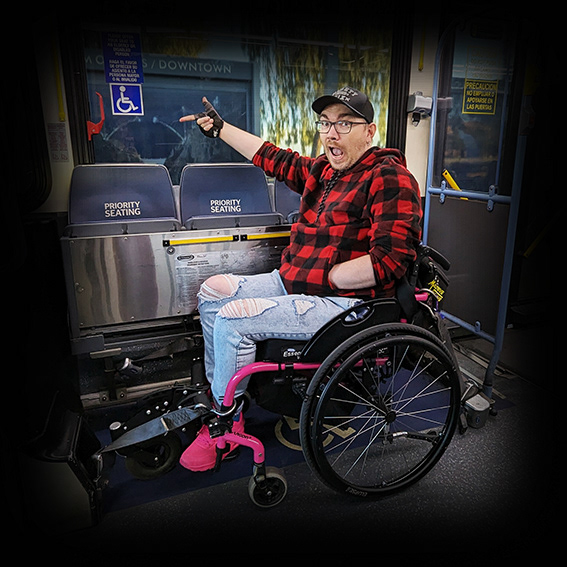
Damian, a white male wearing black framed glasses with a black baseball cap in a pink framed wheelchair. He is wearing a black and red checked hoodie, ripped blue jeans and pink shoes. His chair is positioned in a wheelchair bay on a public bus in Las Vegas, with his chair securely clamped in. The camera is to Damian’s left hand side. He has his left hand in his pocket, his right hand is pointing to a disabled logo on the bus window and he has a surprised open-mouthed look on his face, looking towards the camera

Damian, a white male wearing black framed glasses with a black baseball cap in a pink framed wheelchair. He is wearing a black and red checked hoodie, grey jeans and pink shoes. His chair is positioned in front of the O2 Arena in Greenwich, London. The camera is positioned low, pointing up towards him. He is smiling and both hands are making a rock devil horns hand gesture
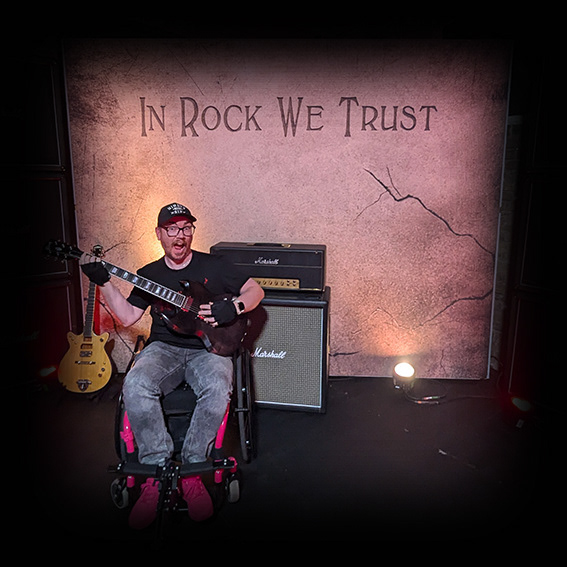
Damian, a white male wearing black framed glasses with a black baseball cap in a pink framed wheelchair. He is wearing a black t-shirt, grey jeans and pink shoes. His chair is positioned in front of a photo studio backdrop made to look like stone with cracks in. There is an amplifier behind him to his left and he is holding an electric guitar. He has an excited open-mouthed gesture.
When I met Alison, my now wife, in my very late teens, she was the first person I really opened up to about my struggles and how things could deteriorate over the future years.
I would let her see my vulnerabilities, but not other people. I wore joint supports under my clothes so no one could see them, I avoided situations where it would be seen that I couldn’t join in, and I masked my pain. Close friends knew I had problems with my knees but that’s as far as it ever really went.
It wasn’t until I was into my mid-20s that I really started to realise I needed to be more honest about my struggles and to be fair, be more honest with myself!
I was receiving long-term medical care and support, but I needed to go a step further and accept I wasn’t ever going to get ‘better’, and it was time to ‘own it’.
I started looking into additional help and support and realising that there were places and people out there who could make life experiences better, safer, and more manageable.
Being young and parking with a blue badge always gets dirty looks and people assume if you’ve got a limp at that age, it’s from a football injury. I still masked the real issues, but I was becoming more aware of myself. Even then, it wasn’t really until my mid-30s that I took the mask off, accepted who I was, and took those first steps to being openly disabled.
When my rheumatologist spoke to me about prescribing me a wheelchair I was horrified. Was that what I wanted? Would I still be able to be ‘me’? Would I become reliant on others?
That afternoon in the hospital didn’t feel like it at the time, but it was a massive turning point for me. My chair gave me a whole new life. Nothing is ever going to take the pain away or fix the degenerative condition, but I now had a new pink comfort blanket.
In my chair, I feel safe. I have some level of protection. In busy places, a person simply knocking into me can cause multiple dislocations. People can’t see how fragile I am and how I need protection, yet being in my chair gives me a protective ring and that visual marker that I have a disability.
Not everyone wants to shout about their disability, but I feel my chair makes people aware of me. It’s given me freedom.
There is, of course, a negative side to being more visibly disabled – people want to ask questions. Oh, what happened to you? Why are you in a wheelchair? Was it an accident? Can you walk? Do you NEED to use the chair?
Personally, this doesn’t offend me. I’m quite open and willing to share, but for many disabled people, it’s very triggering and brings back traumatic memories.
For me, though, answering people’s questions has helped them too. Where did you get your chair from? What does your front wheel do? How do you (insert query here!)? Maybe it’s because I look the way I do that people feel they can approach me.
So many disabled people say that people don’t talk TO them, they speak OVER them or speak to their companion. This is very rarely the case for me. Admittedly, it’s usually ‘I love your shoes’ but it does break the ice!
I’m limited to how much I can push myself but thanks to power add-ons and technology, I’m not 100% reliant on someone pushing me. I can get around much more easily with less discomfort. I can do things for longer. Days out aren’t restricted to short stays and lots of breaks. I can spend time with friends without worrying I won’t be able to stay out long.